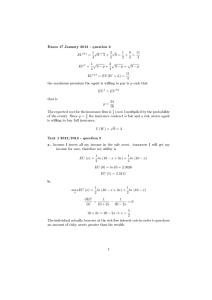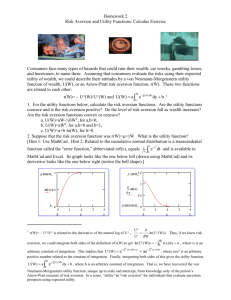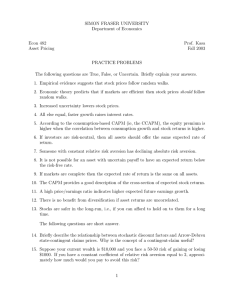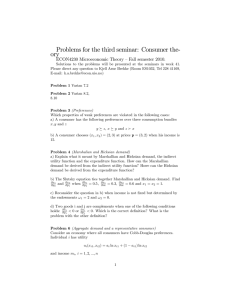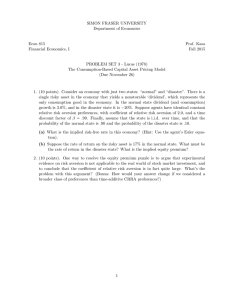The Incentive Implications of Incomplete Insurance
advertisement
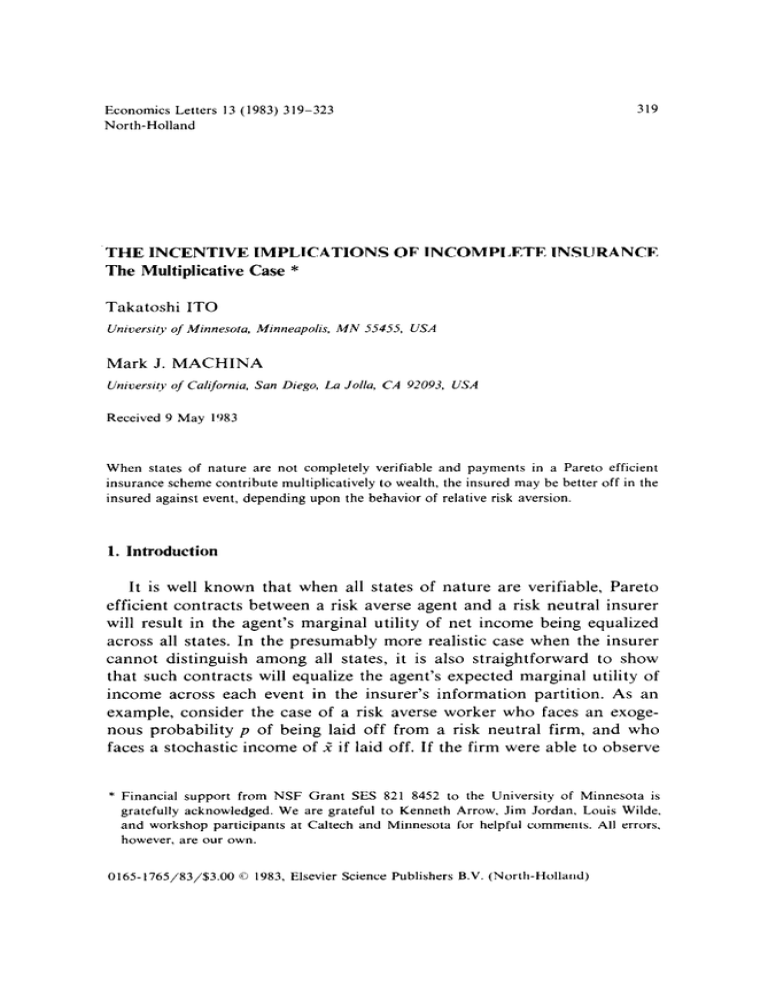
Economics Letters North-Holland 319 13 (1983) 319-323 THE INCENTIVE IMPLICATIONS The Multiplicative Case * Takatoshi OF INCOMPLETE INSURANCE IT0 Unioersrty of Minnesota, Minneapolis, MN 55455, USA Mark J. MACHINA (/nioersrty of Cdi’orma, Received San Diego, La Jolla, CA 92093, USA 9 May 1983 When states of nature are not completely verifiable and payments in a Pareto efficient insurance scheme contribute multiplicatively to wealth, the insured may be better off in the insured against event, depending upon the behavior of relative risk aversion. 1. Introduction It is well known that when all states of nature are verifiable, Pareto efficient contracts between a risk averse agent and a risk neutral insurer will result in the agent’s marginal utility of net income being equalized across all states. In the presumably more realistic case when the insurer cannot distinguish among all states, it is also straightforward to show that such contracts will equalize the agent’s expected marginal utility of income across each event in the insurer’s information partition. As an example, consider the case of a risk averse worker who faces an exogenous probability p of being laid off from a risk neutral firm, and who faces a stochastic income of 1 if laid off. If the firm were able to observe * Financial support from NSF Grant SES 821 8452 to the University of Minnesota is gratefully acknowledged. We are grateful to Kenneth Arrow. Jim Jordan, Louis Wilde, and workshop participants at Caltech and Minnesota for helpful comments. All errors, however. are our own. 0165-1765/83/$3.00 0 1983, Elsevier Science Publishers B.V. (North-Holland) 320 T. Ito, M.J. Machina / Incentive the worker’s satisfy V(w)= income U’(x+s(x)) when imphcamns of umvnplete laid off, the efficient insurance wage contract forallx, would (1) where U( .) is the worker’s von Neumann-Morgenstern utility function, w is the wage when employed, and s(x) is the severance payment as a function of x. ’ If the firm cannot observe 1 but only knows its distribution, the severance payment can no longer depend upon x, and the efficient wage contract satisfies (2) ZY(w)=E[U;(I+s)], where E[ .] is the expectations operator with respect to i-. Although the above examples assumed a fixed layoff probability, eq. (2) would also constitute one of the conditions of an efficient contract if the layoff probability were dependent upon the actions of the worker (e.g., when layoffs are due to at least partially preventable accidents). In such a case it is crucial to verify whether or not the worker’s expected utility would be higher if laid off than if retained. In an earlier work, Imai, Geanakoplos and Ito (1981) showed that U(w) will be greater than, equal to, or less than E[U(1+ s)] ,depending upon whether the worker’s degree of absolute risk aversion - U’( y)/U’( y) is increasing, constant, or decreasing in y. Since it is usually assumed that absolute risk aversion is decreasing in income, this implies the disturbing result that such efficient wage contracts pose a moral hazard problem in that workers have an incentive to be laid off and collect the severance payment. The purpose of this note is to both give an intuitive explanation of the above result as well as to extend the result to the case of multiplicative risk. 2. Intuition The above result of Imai, Geanakoplos and Ito may be immediately from two results of Diamond and Stiglitz and first result is that if one increasing utility function is more another, then any change in the distribution of random ’ Since we consider only the case of state independent implies that x + s(x) = w. utility functions seen to follow Mirrlees. The concave than income which in this note, (1) T. Ito, M.J. Machina / Incentwe mplicatmns of tncomplete insurance 321 constitutes a mean utility preserving increase in risk for the second utility function will lower the expectation of the first [Diamond and Stiglitz (1974, p. 346)]. The second result is that a concave utility function U( .) will exhibit decreasing (increasing) absolute risk aversion if and only if the (increasing) function - U’( .) is more (less) concave than U( -) [Mirrlees (1976)]. Thus, since the change in the distribution of income from the certain value w to the random value 2 + s is seen from (2) to constitute a mean utility preserving increase in risk for u’( .) [and hence for - u’(.)], this change will raise or lower the expectation of U( .) [i.e., E[U(Z + s)] will be greater or less than U(w)] depending upon whether absolute risk aversion is decreasing or increasing. 3. The multiplicative risk case We consider now the case where the size of the severance payment contributes multiplicatively to the worker’s income when laid off. This would occur, for example, if the payment took the form of shares of a risky asset with gross yield P (or else a fixed payment that the worker intended to invest in such an asset), or alternatively, where the payment took the form of training or some other contribution to human capital which has a random productivity of zz in the marketplace. In this case it is clear that the efficient wage contract will satisfy U’(w) = E[X+_?)], (3) or equivalently su’( w) = E[sXJ’(sZ)], and the relevant utility Defining z to solve zU’( z) = E[sZU’(sn)], (4) comparison is now between U(w) and E[U(sl)]. (5) and noting that yU’(y) is an increasing (decreasing) function of y depending upon whether the relative risk aversion index -y U”( y)/u’( y ) of U( .) is less than (greater than) unity, we have from the Diamond and Stiglitz result that U(r) will be greater than (less than) E[U(sZ)] depending upon whether (i) the increasing function yU’(y) is less (more) concave than U(y) in the case where relative risk aversion is everywhere 322 T. Ito, M.J. Mnchrna / Incentive rmplications of uromplete rnsurmce less than unity, or upon whether (ii) the increasing function -yU’(y) is less (more) concave than U(y) in the case when relative risk aversion is everywhere greater than unity. This may be shown to be algebraically equivalent to the condition that -vU”( y)/u’( y) monotonically diverges from (approaches) unity from either above or below as y increases. In order to determine whether U(w) is greater or less than E[ U( s.?)] it remains to compare z with w. Since (4) and (5) imply zU’( z) = sU’( w), the answer depends upon whether s is greater or less than w [i.e., whether sU’(w) is greater or less than WV(W)] and whether zu’(z) is increasing or decreasing in z (i.e., whether relative risk aversion is less or greater than unity). We see that z will be greater than (less than) w when s - w and (relative risk aversion - 1) have opposite (common) signs. Combining the above, we have that (i) U(w) will be greater than E[U(sZ)] if either s > w and -yU”(y)/U’(y) is increasing away from unity or else s < w and -_yU”(y)/u’(y) is declining away from unity, (ii) U(w) will be less than E[ U( si)] if either s > w and -yU”( y)/U’( y) is increasing toward unity or else s < w and -y U”( y )/U’( y ) is declining toward unity, or else (iii) the sign of U(w) - E[U(sl)] will depend upon more specific properties of U( .) and x. * Although it is reasonable to assume that severance payments are less than wages, 3 there is little agreement in the literature concerning the size or behavior of relative risk aversion [compare Arrow (1974, ch. 3), Blume and Friend (1975), Cohn, Lewellen, Lease and Schlarbaum (1975), Friend and Blume (1975) Siegel and Hoban (1982)]. The above result on the incentive implications of this aspect of preferences serves to highlight the importance of further empirical research into this area. ’ It is straightforward to show that the conditions in (i) and (ii) may be weakened to include a weak inequality on either s vs. w or else on d[ - _vI/“():)/U’(y)]/d~. For a more detailed treatment, see Ito and Machina (1983). ’ If eqs. (2) and (3) are to realistically characterize actual contracts then w and s should represent the capitalized values of wages and severance payments over the relevant time horizon, and U( .) the corresponding utility of wealth function. T. Ito, M.J. Machina / Incentroe implicattons of incomplete insurance 323 References Arrow, Kenneth J., 1974, Essays in the theory of risk-bearing (North-Holland, Amsterdam). Blume, Marshall E. and Irwin Friend, 1975, The asset structure of individual portfolios and some implications for utility functions, Journal of Finance 30, 585-603. Cohn, Richard A., Wilbur G. Lewellen, Ronald C. Lease and Gary G. Schlarbaum, 1975, Individual investor risk aversion and investment portfolio composition, Journal of Finance 30, 605-620. Diamond, Peter A. and Joseph E. Stiglitz, 1974, Increases in risk and in risk aversion, Journal of Economic Theory 8, 337-360. Friend, Irwin and Marshall E. Blume, 1975, The demand for risky assets, American Economic Review 65, 900-922. Imai, Haruo, John Geanakoplos and Takatoshi Ito, 1981, Incomplete insurance and absolute risk aversion, Economics Letters 8, 107-l 12. Ito. Takatoshi and Mark J. Machina, 1983, The incentive implications of incomplete insurance: The multiplicative case, Department of Economics discussion paper no. 83 - 175 (University of Minnesota, Minneapolis, MN). Mirrlees, James, 1976, Risk and risk aversion, Mimeo. notes (MIT, Cambridge, MA). Siegel, Frederick Vi. and James P. Hoban, 1982, Relative risk aversion revisited, Review of Economics and Statistics 64. 481-487.
